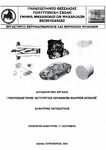| dc.description.abstract | The new emission control regulations for the diesel engines impose less
soot particulate emissions. The particulates are dangerous and very harmful
for the enviroment. Today, the CO and HC emissions of the diesel engines are
already very low but the NOx and particulates emissions are still high. These
are the goal of the modern emission control technologies. The reduction of
the NOx and particulates emitted can be reduced with improvements in the
engine design, fuel, oil and additive technologies and with exhaust after
treatment.
The soot filters collect the particulates from the diesel engine exhaust
gas. The filter efficiency can be over 90% and the durability is satisfactory.
When the trap's soot load is high the regeneration is necessary to retain the
efficiency and to avoid the filter failure. The regeneration methods must be
further developed in order to avoid problems cause from the heat released
during the combustion of the soot. These problems must be completely
solved, for the soot traps to become a common used emission control device
in passenger cars.
Today, soot filters in passenger cars are used only from PSA, but the
emission control regulations in the future will impose every vehicle with a
diesel engine to have reduced particulates emissions. That will lead in the
wide use of soot filters.
The design and improvement of soot traps can be much more easier,
more efficiently and with less cost with the use of soot filter simulation
software. Many tests and modifications can be made, avoiding the
experimental cost. Besides, many parameters of the filter function can be
computed and analysed faster and reliably.
The diploma thesis with title 'Modeling of ceramic soot filters' was
conducted within the purposes of the research project 'Development of
computational tools for exhaust after-treatment systems design
optimization' for PSA Peugeot Citroen, at the Laboratory of
Thermodynamics and Thermal Engines, of the Department of Mechanical and
Industrial Engineering.
The goal of the diploma thesis is the presentation of the basics of soot
traps and the calculations conducted with the soot filter simulation software
Catwall. The validation of the model as well as to find the points that need to
be improved are a part of the thesis.
The properties of the materials, soot and insulation were defined and
there was an effort to choose the most suitable kinetics scheme for the soot
combustion and the additive reaction.
The first chapter describes the emissions of the diesel engines, the
emissions regulations, the soot particulates, the soot filters basics,
regeneration, materials and the fuel additive.
The second chapter deals with the modeling of the experiments of the
small filters, conducted by PSA. The experiments are described and the
results from the calculations are compared with the measurements with SiC
and Cordierite filters. In the next chapter the experiments conducted with insulated filters by
the IFP are described and then the temperature and ΔΡ calculations are
presented. The effort to choose the most suitable kinetics parameters follows
as well as the comparison of 4 kinetics schemes for the soot combustion
without additive.
The forth chapter describes the experiments conducted at the
Laboratory of Thermodynamics and Thermal Engines. The results from the
calculations are compared with the measurements with SiC and Cordierite
filters and there is also an effort to choose the most suitable kinetics scheme,
with a comparison of 4 kinetics schemes for the soot combustion with
additive.
The model is described in appendix I and the preprocessing and
postprocessing of the experimental data are presented in appendix II.
The conclusions from the calculations are presented in order to improve
the source code and to suggest the conduction of new experiments, which
will help in achieving this goal. Finally many remarks are made on the results,
which confirm the literature data or describe the effect of the regeneration
parameters on the calculations, which need to be further searched through. | en |



